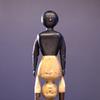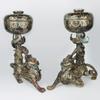Lyman Allyn Art Museum Opens New Permanent Exhibit Dedicated To Louis Comfort Tiffany
- NEW LONDON, Connecticut
- /
- November 14, 2018
The Lyman Allyn Art Museum, in New London, Conn., has opened a new permanent exhibit, dedicated to the life and works of American artist and designer, Louis Comfort Tiffany (1848 – 1943), who was best known for his innovative work with stained glass. The installation features three newly conserved stained glass windows which were commissioned in the early 1900s to memorialize loved ones in New London.
The collection, which showcases never before exhibited objects (many of which came from the artist’s descendants), illustrate Tiffany’s early career as a painter, then show his work as an interior designer, and tell the story of his innovations and success as a glassmaker. With items both from the museum’s collection and on loan, the exhibit includes nearly 100 pieces of decorative arts and fine arts objects including a range of windows, lamps, paintings, period photographs, furniture, metalworks, glass samples and finished Favrile glass vessels, as well as jewelry and adornments. The works are displayed in the museum’s Chappell Gallery, a 1,070 square foot space devoted to the artist.
“Louis Comfort Tiffany is known as one of the most creative and versatile artists of his era. This new exhibit which provides a comprehensive and insightful look at his many works and the range of cultural influences he experienced, allows us to tell a rich story about his life and career,” stated Museum Director, Sam Quigley. “We are thrilled to join the ranks of noteworthy institutions such as the Metropolitan Museum of Art, The Corning Museum of Glass and the Morse Museum in Florida, that offer a focused collection from this very important artist,” he added.
Much of Tiffany’s success was driven by technical innovations in blown and stained glass. As such, the exhibit presents the creativity, history, and artistry that Tiffany and his craftspeople used to create vivid new effects in glass. They made multi-colored iridescent surfaces and deep colors, textures, and other effects to make the glass itself mimic the versatility of a painted canvas. This type of iridescent glass with distinctive coloring in which the color is ingrained in the glass itself became known as Favrile glass. Tiffany patented the process in 1894 and first produced the glass for manufacture in Queens, New York in 1896.
The museum also provides several short and informative videos which explore Tiffany family history, the patronage of Tiffany windows and the conservation and preservation of the windows installed in the gallery. The videos were created by Todd Gipstein, an award winning writer, photographer, and producer whose work has been featured in National Geographic.
A lecture series was also launched in November, 2018. The series kicked off with a presentation focused around Agnes Northrop, a noted independent female designer for Tiffany Studios, with a lecture delivered by renowned Tiffany expert and author Alice Cooney Frelinghuysen, the Andrew W. and Lulu C. Wang Curator of American Decorative Arts at the Metropolitan Museum of Art in New York.
“A wide range of cultural influences informed the art and design of the Gilded Age, bringing objects, designs, and ideas from around the world to America and to this region,” noted Tanya Pohrt, Special Project Curator. “Tiffany’s fascination with the art and culture of the middle east and the far east illustrates the global and cosmopolitan nature of American art and design in this era,” she added.
Some notable pieces in the exhibit include the Dragonfly Lamp, ca 1906. Tiffany Studios, designed by Clara Driscoll, as well as two stained glass windows from the Frank Loomis Palmer (1851-1917) Mausoleum, Cedar Grove Cemetery, New London. River of Life window, probably J & R Lamb Studios, ca. 1904-1910, and Saint Cecilia window, Tiffany Studios, ca. 1913.
Today, the Tiffany family name is most commonly associated with Tiffany & Co., a prestigious American luxury jewelry and specialty retailer, founded in New York in 1837 by Louis Comfort’s father, Charles L. Tiffany. By the 1870s and 1880s, Tiffany & Co. was the world’s premier source for luxury goods, serving royalty and the wealthy industrialists who led America’s Gilded Age. Tiffany’s son, Louis Comfort Tiffany established his own firms specializing in arts and decorative glass. His firm designed interiors and furnishing for many notable clients including President Chester Arthur’s White House and Mark Twain’s mansion. Later following the death of Charles Lewis Tiffany in 1902, the younger Tiffany stepped in, becoming primary shareholder and design director at Tiffany & Co., a title he held until 1919.



















100x100_c.jpg)